seats CADILLAC ESCALADE EXT 2002 2.G Owners Manual
[x] Cancel search | Manufacturer: CADILLAC, Model Year: 2002, Model line: ESCALADE EXT, Model: CADILLAC ESCALADE EXT 2002 2.GPages: 427, PDF Size: 3.16 MB
Page 2 of 427
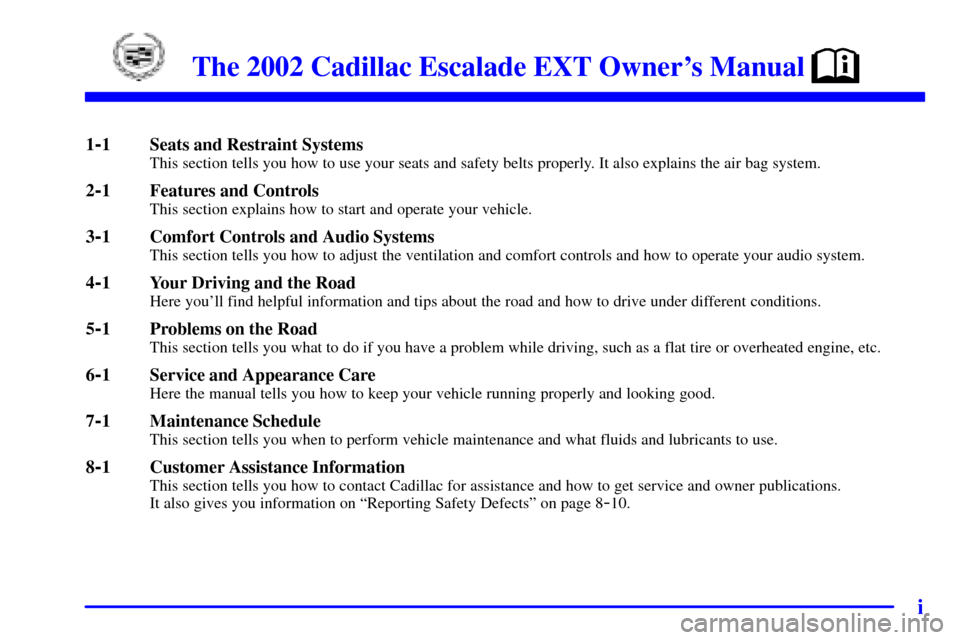
i
1-1 Seats and Restraint Systems
Page 7 of 427
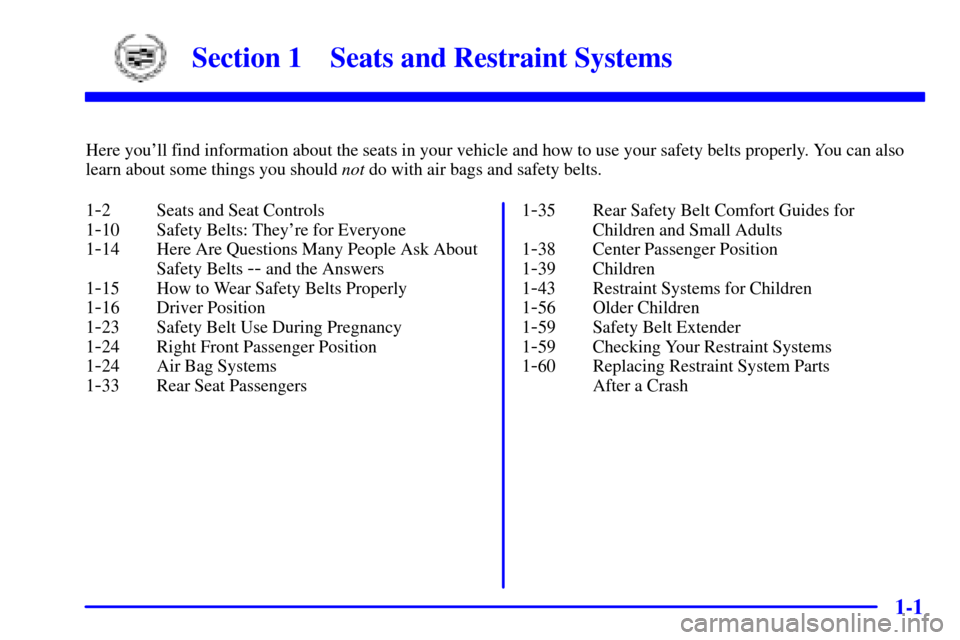
1-
1-1
Section 1 Seats and Restraint Systems
Here you'll find information about the seats in your vehicle and how to use your safety belts properly. You can also
learn about some things you should not do with air bags and safety belts.
1
-2 Seats and Seat Controls
1
-10 Safety Belts: They're for Everyone
1
-14 Here Are Questions Many People Ask About
Safety Belts
-- and the Answers
1
-15 How to Wear Safety Belts Properly
1
-16 Driver Position
1
-23 Safety Belt Use During Pregnancy
1
-24 Right Front Passenger Position
1
-24 Air Bag Systems
1
-33 Rear Seat Passengers1
-35 Rear Safety Belt Comfort Guides for
Children and Small Adults
1
-38 Center Passenger Position
1
-39 Children
1
-43 Restraint Systems for Children
1
-56 Older Children
1
-59 Safety Belt Extender
1
-59 Checking Your Restraint Systems
1
-60 Replacing Restraint System Parts
After a Crash
Page 8 of 427
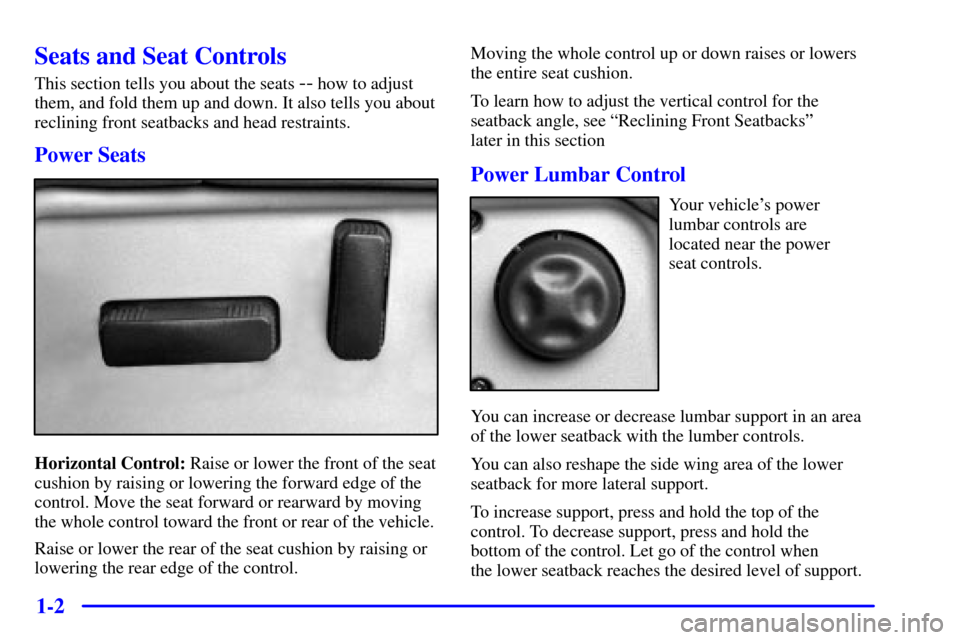
1-2
Seats and Seat Controls
This section tells you about the seats -- how to adjust
them, and fold them up and down. It also tells you about
reclining front seatbacks and head restraints.
Power Seats
Horizontal Control: Raise or lower the front of the seat
cushion by raising or lowering the forward edge of the
control. Move the seat forward or rearward by moving
the whole control toward the front or rear of the vehicle.
Raise or lower the rear of the seat cushion by raising or
lowering the rear edge of the control.Moving the whole control up or down raises or lowers
the entire seat cushion.
To learn how to adjust the vertical control for the
seatback angle, see ªReclining Front Seatbacksº
later in this section
Power Lumbar Control
Your vehicle's power
lumbar controls are
located near the power
seat controls.
You can increase or decrease lumbar support in an area
of the lower seatback with the lumber controls.
You can also reshape the side wing area of the lower
seatback for more lateral support.
To increase support, press and hold the top of the
control. To decrease support, press and hold the
bottom of the control. Let go of the control when
the lower seatback reaches the desired level of support.
Page 11 of 427
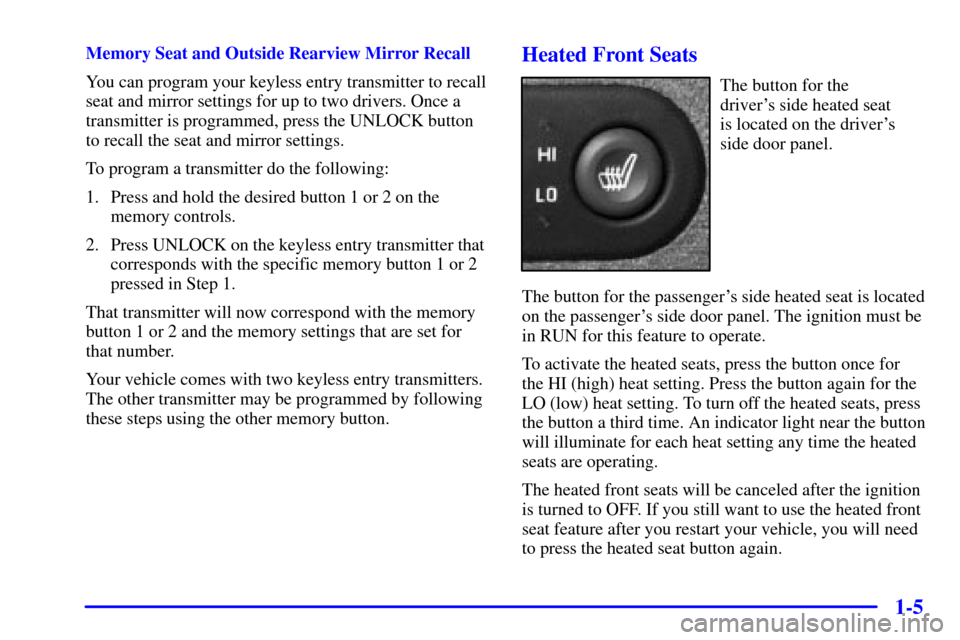
1-5
Memory Seat and Outside Rearview Mirror Recall
You can program your keyless entry transmitter to recall
seat and mirror settings for up to two drivers. Once a
transmitter is programmed, press the UNLOCK button
to recall the seat and mirror settings.
To program a transmitter do the following:
1. Press and hold the desired button 1 or 2 on the
memory controls.
2. Press UNLOCK on the keyless entry transmitter that
corresponds with the specific memory button 1 or 2
pressed in Step 1.
That transmitter will now correspond with the memory
button 1 or 2 and the memory settings that are set for
that number.
Your vehicle comes with two keyless entry transmitters.
The other transmitter may be programmed by following
these steps using the other memory button.Heated Front Seats
The button for the
driver's side heated seat
is located on the driver's
side door panel.
The button for the passenger's side heated seat is located
on the passenger's side door panel. The ignition must be
in RUN for this feature to operate.
To activate the heated seats, press the button once for
the HI (high) heat setting. Press the button again for the
LO (low) heat setting. To turn off the heated seats, press
the button a third time. An indicator light near the button
will illuminate for each heat setting any time the heated
seats are operating.
The heated front seats will be canceled after the ignition
is turned to OFF. If you still want to use the heated front
seat feature after you restart your vehicle, you will need
to press the heated seat button again.
Page 14 of 427
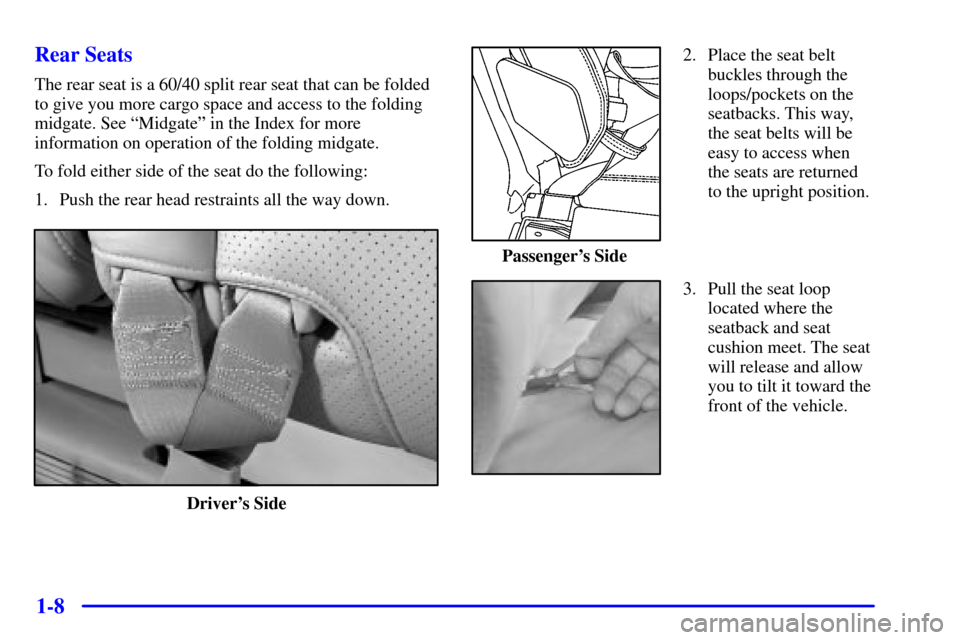
1-8 Rear Seats
The rear seat is a 60/40 split rear seat that can be folded
to give you more cargo space and access to the folding
midgate. See ªMidgateº in the Index for more
information on operation of the folding midgate.
To fold either side of the seat do the following:
1. Push the rear head restraints all the way down.
Driver's Side
2. Place the seat belt
buckles through the
loops/pockets on the
seatbacks. This way,
the seat belts will be
easy to access when
the seats are returned
to the upright position.
Passenger's Side
3. Pull the seat loop
located where the
seatback and seat
cushion meet. The seat
will release and allow
you to tilt it toward the
front of the vehicle.
Page 15 of 427
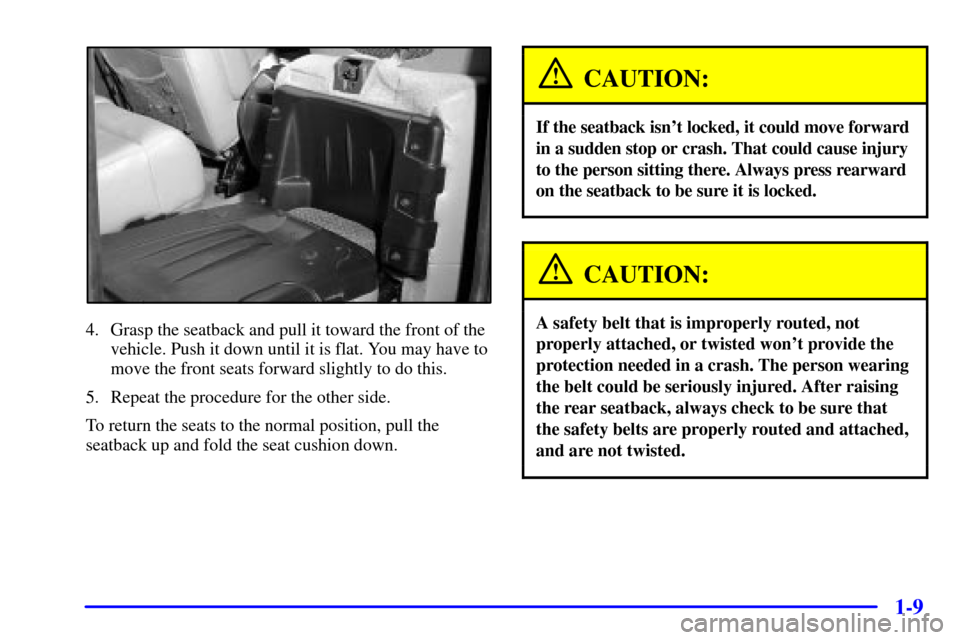
1-9
4. Grasp the seatback and pull it toward the front of the
vehicle. Push it down until it is flat. You may have to
move the front seats forward slightly to do this.
5. Repeat the procedure for the other side.
To return the seats to the normal position, pull the
seatback up and fold the seat cushion down.
CAUTION:
If the seatback isn't locked, it could move forward
in a sudden stop or crash. That could cause injury
to the person sitting there. Always press rearward
on the seatback to be sure it is locked.
CAUTION:
A safety belt that is improperly routed, not
properly attached, or twisted won't provide the
protection needed in a crash. The person wearing
the belt could be seriously injured. After raising
the rear seatback, always check to be sure that
the safety belts are properly routed and attached,
and are not twisted.
Page 16 of 427
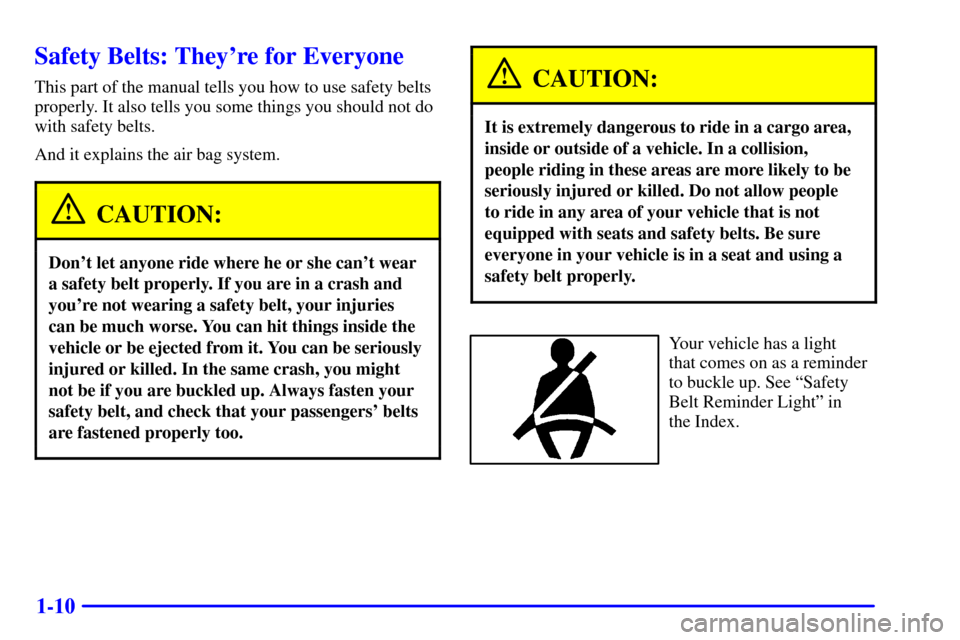
1-10
Safety Belts: They're for Everyone
This part of the manual tells you how to use safety belts
properly. It also tells you some things you should not do
with safety belts.
And it explains the air bag system.
CAUTION:
Don't let anyone ride where he or she can't wear
a safety belt properly. If you are in a crash and
you're not wearing a safety belt, your injuries
can be much worse. You can hit things inside the
vehicle or be ejected from it. You can be seriously
injured or killed. In the same crash, you might
not be if you are buckled up. Always fasten your
safety belt, and check that your passengers' belts
are fastened properly too.
CAUTION:
It is extremely dangerous to ride in a cargo area,
inside or outside of a vehicle. In a collision,
people riding in these areas are more likely to be
seriously injured or killed. Do not allow people
to ride in any area of your vehicle that is not
equipped with seats and safety belts. Be sure
everyone in your vehicle is in a seat and using a
safety belt properly.
Your vehicle has a light
that comes on as a reminder
to buckle up. See ªSafety
Belt Reminder Lightº in
the Index.
Page 22 of 427
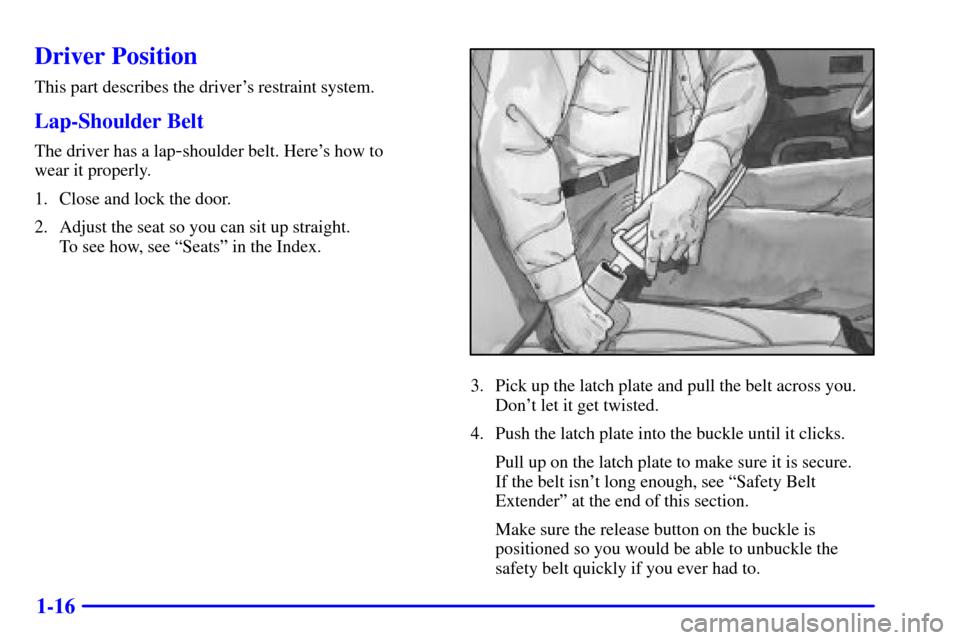
1-16
Driver Position
This part describes the driver's restraint system.
Lap-Shoulder Belt
The driver has a lap-shoulder belt. Here's how to
wear it properly.
1. Close and lock the door.
2. Adjust the seat so you can sit up straight.
To see how, see ªSeatsº in the Index.
3. Pick up the latch plate and pull the belt across you.
Don't let it get twisted.
4. Push the latch plate into the buckle until it clicks.
Pull up on the latch plate to make sure it is secure.
If the belt isn't long enough, see ªSafety Belt
Extenderº at the end of this section.
Make sure the release button on the buckle is
positioned so you would be able to unbuckle the
safety belt quickly if you ever had to.
Page 41 of 427
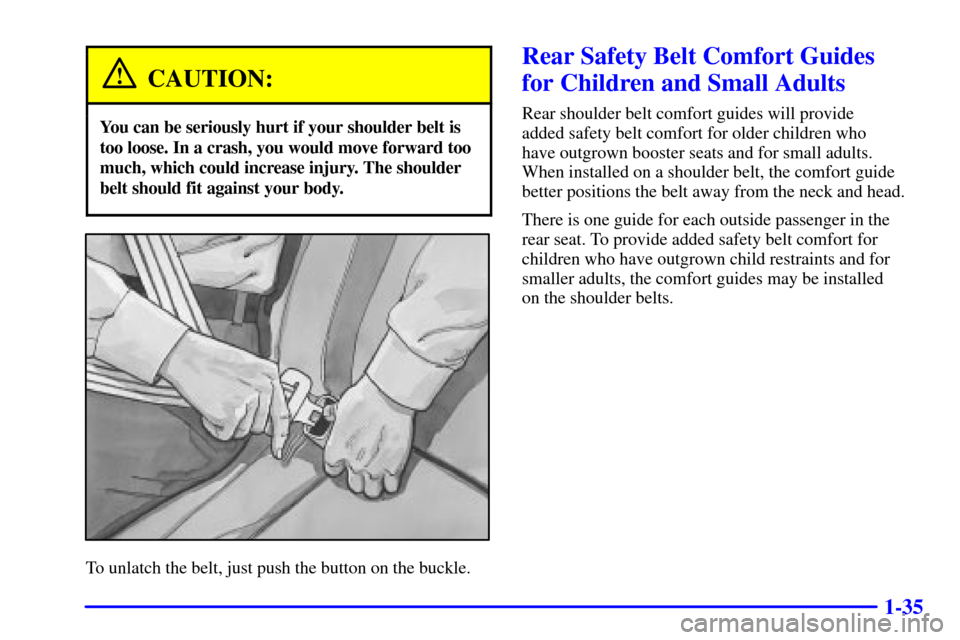
1-35
CAUTION:
You can be seriously hurt if your shoulder belt is
too loose. In a crash, you would move forward too
much, which could increase injury. The shoulder
belt should fit against your body.
To unlatch the belt, just push the button on the buckle.
Rear Safety Belt Comfort Guides
for Children and Small Adults
Rear shoulder belt comfort guides will provide
added safety belt comfort for older children who
have outgrown booster seats and for small adults.
When installed on a shoulder belt, the comfort guide
better positions the belt away from the neck and head.
There is one guide for each outside passenger in the
rear seat. To provide added safety belt comfort for
children who have outgrown child restraints and for
smaller adults, the comfort guides may be installed
on the shoulder belts.
Page 50 of 427
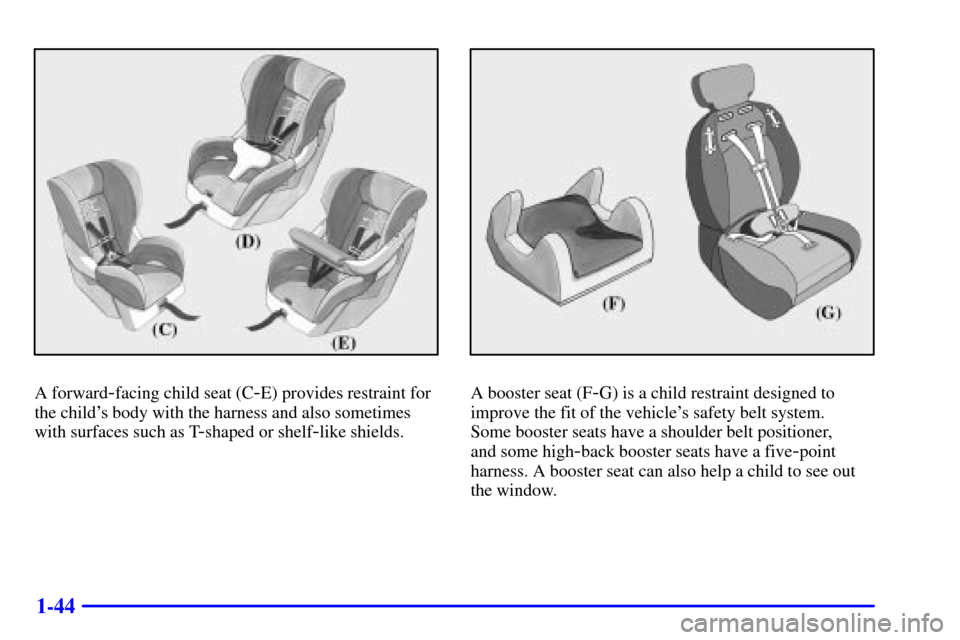
1-44
A forward-facing child seat (C-E) provides restraint for
the child's body with the harness and also sometimes
with surfaces such as T
-shaped or shelf-like shields.
A booster seat (F-G) is a child restraint designed to
improve the fit of the vehicle's safety belt system.
Some booster seats have a shoulder belt positioner,
and some high
-back booster seats have a five-point
harness. A booster seat can also help a child to see out
the window.